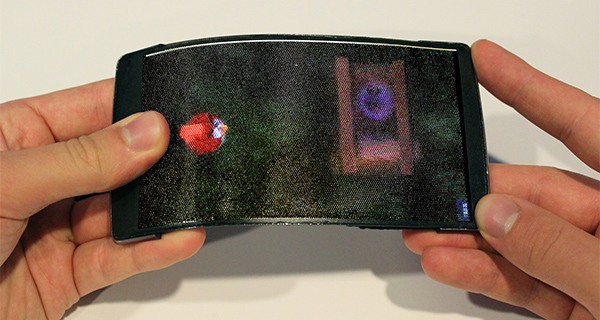A group of researchers from Queen’s University’s Human Media Lab in Ontario have managed to build an innovative smartphone that has been dubbed the HoloFlex. The device itself is designed and manufactured to have an entirely flexible body, as well as an integrated holographic display that can literally take on-screen content and explode it into a 3D viewing experience that can be enjoyed from any angle by multiple people, and doesn’t require special glasses, complex head tracking, or extremely expensive projectors to bring the functionality to life.
Not only is HoloFlex being dubbed as the first holographic flexible smartphone, but it also breaks convention by representing 3D content in a very different manner. Rather than creating two images – like traditional 3D displays do for each individual eye – the HoloFlex has a vast array of tiny little lenses that are embedded and overlaid onto the flexible HD OLED display. The display is broken up into 16,000 12-pixel circles, with each lens being tasked with displaying a different view of the object on the display. This is how the 3D effect is achieved, therefore negating the need for any additional viewing accessory.

In addition to offering this new and unique 3D viewing experience, the HoloFlex also brings additional innovation by allowing users to interact and utilize the flexible display in a new way. Rather than simple accepting gesture or touch-based input, the Human Media Lab have afforded the HoloFlex display with the ability to be bent back and forward in order to interact with objects and move them around in the virtual space, just like the ReFlex smartphone before it.
Going a little above that type of interaction, with HoloFlex being paired with a depth camera, Professor Dr. Roel Vertegaal of Queen’s University School of Computing believes the HoloFlex could be used for 3D video conferencing:
By employing a depth camera, users can also perform holographic video conferences with one another. When bending the display users literally pop out of the screen and can even look around each other, with their faces rendered correctly from any angle to any onlooker.
The basis of the project, and the innovation that goes with it, is definitely in place. However, the technology requires work until it’s perfected and ready to be classed as a real project. “HoloFlex is powered by a 1.5 GHz Qualcomm Snapdragon 810 processor and 2 GB of memory. The board runs Android 5.1 and includes an Adreno 430 GPU supporting OpenGL 3.1.” The flexible ReFlex display boasts a 1080p quality, but the output image actually ends up with a pixel resolution of 160-by-104 after being fed through the HoleFlex lens.
(Source: Human Media Lab)
You can follow us on Twitter, add us to your circle on Google+ or like our Facebook page to keep yourself updated on all the latest from Microsoft, Google, Apple and the Web.

